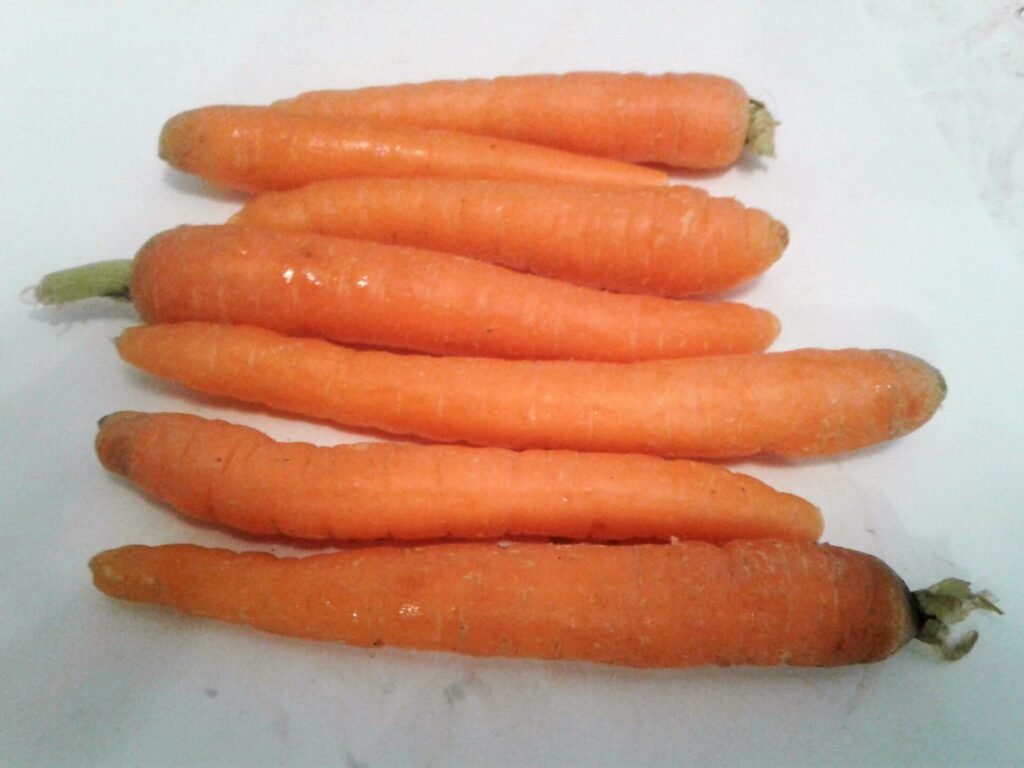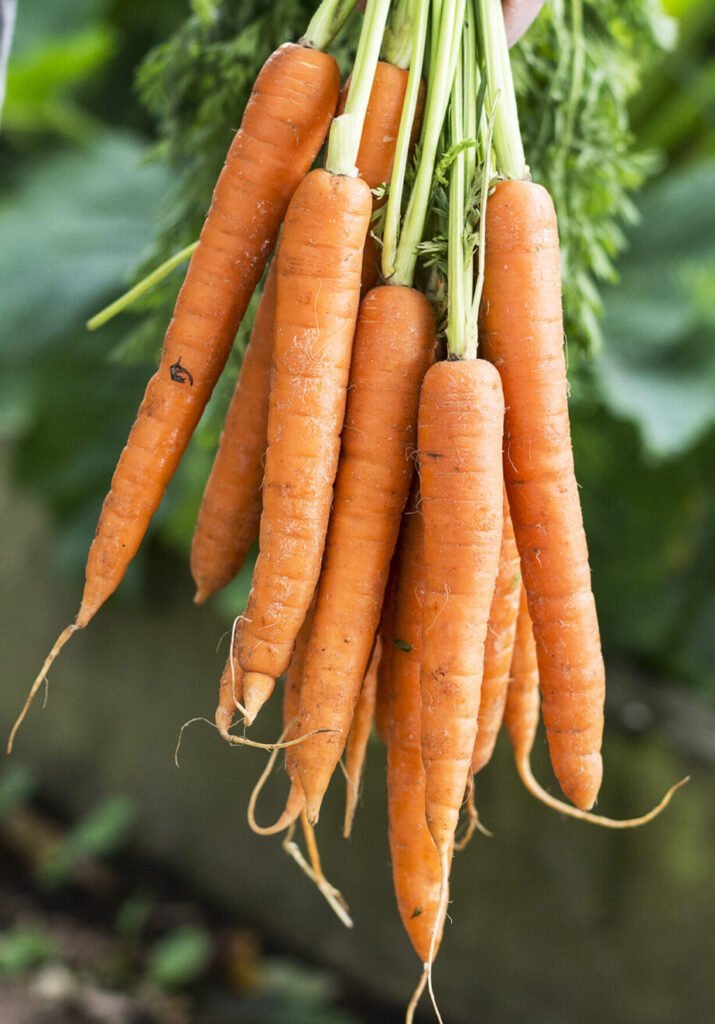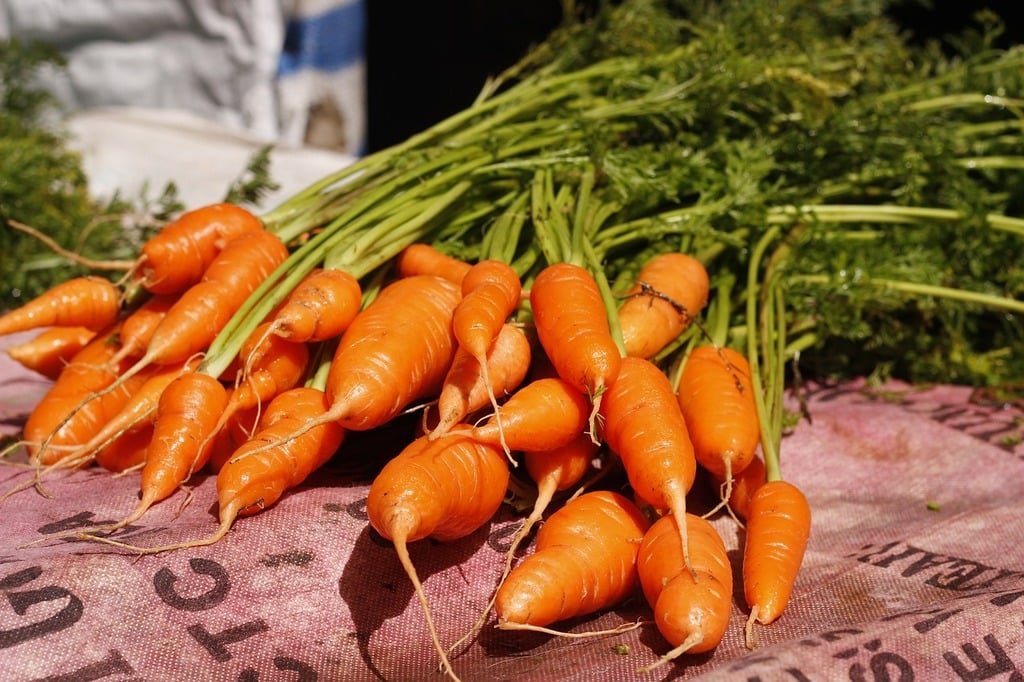Growing carrots, scientifically known as Daucus carota, has a storied history dating back thousands of years. Originating in Persia, which is modern-day Iran and Afghanistan, carrots were initially cultivated for their aromatic leaves and seeds. The familiar orange carrot, however, did not emerge until the 10th century in the Netherlands through selective breeding. Today, carrots are a staple in cuisines worldwide, celebrated for their versatility and exceptional nutritional benefits.

Rich in beta-carotene, which the body converts into vitamin A, carrots are essential for maintaining healthy vision, skin, and immune function. They also provide dietary fiber, antioxidants, and vitamins and minerals such as vitamin K, vitamin C, potassium, and manganese.
There are numerous varieties of carrots, each with unique characteristics, making them a rewarding choice for gardeners of all skill levels. Common types include the classic orange carrot, as well as purple, red, yellow, and white varieties. Nantes carrots are known for their sweet taste and crisp texture, ideal for fresh consumption, while Danvers carrots, with their robust flavor and hardiness, are excellent for cooking and storage. Imperator carrots, often found in grocery stores, are long and tapered, prized for their high sugar content. Carrots’ relatively straightforward cultivation requirements and the variety of types available make them an excellent addition to any gardening repertoire.
Choosing the Right Carrot Variety
When it comes to growing carrots, selecting the right variety is crucial for achieving a bountiful harvest. Carrots come in several types, each with distinct characteristics that make them suitable for different growing conditions and culinary uses.Understanding the differences between of variations you can pick best carrot for your garden.

Nantes Carrots:
Nantes carrots are known for their cylindrical shape and blunt tips. They typically grow to about 6-7 inches in length and have a sweet, crisp texture. This variety is highly adaptable and grow in many soil types, making it a popular choice for home gardeners. Nantes carrots are also relatively quick to mature, usually ready for harvest in about 65-70 days.
Danvers Carrots:
Danvers carrots are characterized by their conical shape and deep orange color. They are more tolerant of heavy or clay soils compared to other varieties, thanks to their tapered roots that can penetrate harder ground. Danvers carrots generally grow to about 6-8 inches long and have a robust, earthy flavor. They take a bit longer to mature, typically around 75-80 days, but their hardiness makes them a reliable option for challenging soil conditions.


Imperator Carrots:
Imperator carrots are the type most commonly found in grocery stores. They have long, slender roots that can grow up to 10 inches or more, making them ideal for deep, sandy soils. This variety is known for its sweet taste and crunchy texture. Imperator carrots require a longer growing period, usually around 75-80 days, and need well-drained soil to prevent root deformities.
Chantenay Carrots:
Chantenay carrots are shorter and thicker, typically growing to about 5-6 inches in length with broad shoulders. They are well-suited for heavy or rocky soils where other carrot varieties might struggle. Chantenay carrots have a rich, sweet flavor and are excellent for storage. They are ready for harvest in about 65-70 days and are particularly favored for their versatility in both fresh and cooked dishes.

By understanding the type and ideal growing methods of these carrot varieties, you can make an informed decision about which type will thrive in your garden. Whether you are looking for a quick-maturing variety like Nantes or a robust option like Danvers, there is a carrot variety that will meet your needs and enhance your gardening experience.
Preparing the Soil for Growing carrots Planting

Soil Preparation:
- Ensure well-drained, loose soil for easy root penetration.
- Ideal soil type: sandy loam.
- Preferred pH: slightly acidic to neutral (6.0 to 7.0).
- Perform a soil test to determine current pH and nutrient levels.
Improving Soil Quality:
- Make a compost bed a depth of at least 12 inches.
- Avoid fresh manure to prevent introducing weed seeds and diseases.
Using Raised Beds:
- Benefits: better drainage, easier soil management, and reduced soil compaction.
- Ensure raised beds are 12 to 18 inches high for adequate root space.
Enhancing Soil Fertility:
- Apply balanced fertilizer rich in phosphorus and potassium.
- Be cautious with nitrogen levels.
By following these steps, you can create an optimal environment for a bountiful and healthy carrot harvest.
Planting Carrot Seeds
Growing carrots seed requires careful planning and attention to detail to ensure a successful harvest. The optimal time to plant carrot seeds is in early spring. In temperate regions, this typically means late March to early April. For a continuous supply of carrots, you can also plant successive crops every three weeks until midsummer.
When it comes to sowing carrot seeds, proper spacing is crucial. Carrot seeds should be planted in rows that are 12 inches apart, with seeds spaced about 1 inch apart within each row. This spacing allows for adequate room for the roots to develop without competition. Sow the carrot seeds at a depth of about 1/4 inch to 1/2 inch, lightly covered with fine soil. Overseeding can lead to poor root development and smaller carrots, so it is essential to sow the seeds thinly. If necessary, thin the seedlings to the appropriate spacing once they have sprouted and are large enough to handle.

Ensuring even moisture during germination is vital for carrot seeds, as they are slow to germinate and require consistent moisture to sprout. To achieve this, water the soil lightly and regularly, keeping it moist but not waterlogged. A fine mist from a spray bottle can help maintain the proper moisture level without washing away the seeds. Covering the rows with a thin layer of mulch or a floating row cover can also help keep moisture and save the seeds from temperature fluctuations.
By following these guidelines for planting carrot seeds, you can set the stage for a bountiful carrot harvest. Proper timing, spacing, and moisture management are key factors that help carrot plants grow healthy, ensuring that you enjoy the fruits of your labour throughout the growing season.
Caring for Growing Carrot Plants
Watering:
- Consistent moisture is crucial, especially during germination and early growth.
- Avoid waterlogging to prevent root rot.
- General guideline: about an inch of water per week.
Thinning:
- Thin seedlings when they are about two inches tall.
- Space plants approximately two inches apart to ensure optimal growth.
Weeding:
- Continuously watch growing carrots and remove weeds using a hoe.
- Mulching helps suppress weed growth and retain soil moisture.
Pest Management:
- Common pests: carrot flies, aphids, nematodes.
- Use row covers or insect netting as physical barriers.
- Organic options: neem oil and insecticidal soaps.
- Use chemical treatments as a last resort and follow local regulations.
Disease Management:
- Carrots are susceptible to fungal infections (e.g., powdery mildew, leaf blight).
- Ensure proper air circulation and avoid overhead watering.
- Use organic fungicides like copper-based sprays.
- Regular monitoring and prompt action are essential.
Harvesting Carrots
Knowing the right time to harvest carrots is crucial for achieving the best flavour and texture. Several indicators can help you determine when your carrots are ready for harvest. Typically, carrots are mature and ready to be harvested between 70 to 80 days after planting. However, the exact timing can vary depending on the variety and growing conditions. Visual signs to look for include the diameter of the carrot tops, which should be around 1/2 to 3/4 inches wide. Additionally, the colour should be vibrant and consistent with the carrot variety you planted.

Another reliable method to ascertain readiness is through tactile assessment. Gently dig around the base of the carrot tops with your fingers. If the roots feel firm and have reached the desired size, they are likely ready to be pulled from the soil. Be cautious not to damage the carrots during this process, as broken or bruised carrots can spoil more quickly.
When it comes to harvesting techniques, use a garden fork or spade to loosen the soil around the carrots. Insert the tool a few inches away from the carrot tops and gently lift the soil, taking care not to puncture the roots. Once the soil is loose, you can pull the carrots out by their tops. If the tops break off, you can dig around the carrots to free them entirely.
Post-harvest handling is equally essential for maintaining the quality of your carrots. Immediately after harvesting, remove the green tops to prevent them from drawing moisture and nutrients from the roots. Rinse the carrots to remove any soil, but avoid prolonged soaking, which can lead to rot. For optimal storage, place the carrots in a perforated plastic bag and store them in the refrigerator’s crisper drawer. This will help maintain their freshness and crispness. Properly stored carrots can last several weeks, providing you with fresh produce well beyond the growing season.
By following these guidelines for harvesting carrots, you can ensure a bountiful and high-quality yield. Whether you’re a seasoned gardener or a beginner, mastering the art of harvesting will significantly enhance your carrot-growing experience.
Common Problems and Solutions For Growing carrots
Growing carrots can present various challenges that may hinder the successful cultivation of this root vegetable. One common issue gardeners encounter is poor germination. Carrot seeds require a consistent level of moisture for optimal germination. To address this, ensure that the soil remains consistently moist until the seeds sprout. Additionally, planting in well-drained, loose soil can significantly improve germination rates. Avoid heavy clay soils, as they can inhibit the growth of delicate carrot seedlings.
Another frequent problem is the development of forked or misshapen roots. This typically results from obstacles in the soil or inconsistent soil conditions. To prevent this, thoroughly till the soil before planting to remove any stones or debris. Using raised beds can also help by providing a controlled environment with uniform soil texture. Moreover, avoid over-fertilizing with nitrogen-rich fertilizers, as excessive nitrogen can cause branching of the roots.
Pest infestations, particularly from carrot flies, can also pose significant challenges. Carrot flies lay their eggs at the base of young plants, and the larvae feed on the roots, causing stunted growth and rot. Employing row covers can effectively prevent adult flies from accessing the plants to lay eggs. Additionally, intercropping with strong-smelling plants like onions or garlic can deter these pests. Crop rotation is another preventative measure, as it helps break the lifecycle of pests by depriving them of a constant food source.
Maintaining healthy soil is crucial for a successful carrot crop. Regularly test the soil and amend it as necessary to ensure it has the right balance of nutrients. Mulching with organic materials can help retain soil moisture and suppress weeds, further promoting healthy carrot growth. By implementing these practical solutions and preventative measures, gardeners can overcome common problems and enjoy a fruitful carrot harvest.
Recipes and Uses for Homegrown Carrots
Homegrown carrots offer a delightful addition to various culinary creations, providing a fresh, sweet crunch that elevates any dish. Their versatility in the kitchen allows for numerous recipes, ranging from refreshing salads to hearty soups, making them a staple ingredient for any home cook.
One of the simplest yet most satisfying ways to enjoy homegrown carrots is in a fresh carrot salad. Shredded carrots combined with raisins, a splash of lemon juice, and a dash of olive oil create a vibrant, nutritious side dish. For added complexity, consider incorporating nuts like walnuts or almonds, which provide a delightful texture contrast.
Carrot soup is another excellent dish that highlights the natural sweetness of this root vegetable. Start by sautéing onions and garlic in a pot, then add chopped carrots and vegetable broth. Simmer until the carrots are tender, then blend until smooth. For a creamy variation, stir in coconut milk or cream, and season with ginger and cumin to enhance the flavors.
In addition to salads and soups, homegrown carrots can be roasted to perfection. Toss sliced carrots with olive oil, salt, and pepper, then bake at 400°F (200°C) for about 20-25 minutes until caramelized and tender. This simple preparation method intensifies their natural sweetness, making them an ideal side dish for any meal.
To ensure you can enjoy the bounty of your carrot harvest year-round, proper preservation techniques are essential. Carrots can be stored in a cool, dark place for several weeks. For longer storage, consider freezing. Blanch the carrots in boiling water for a few minutes, then plunge them into ice water before freezing. This process helps retain their color and flavor.
Pickling is another preservation method that adds a tangy twist to your homegrown carrots. Combine equal parts vinegar and water with sugar, salt, and spices of your choice, then pour over sliced carrots in a sterilized jar. Seal and refrigerate for at least 24 hours before enjoying.
Incorporating homegrown carrots into your kitchen repertoire not only enhances your meals but also ensures that you make the most of your garden’s yield. With these recipes and preservation tips, you can savor the taste of fresh carrots throughout the year.




1 thought on “Growing Carrots: A Comprehensive Guide”